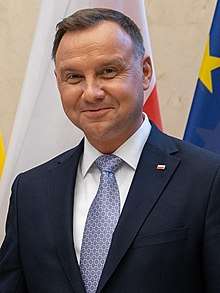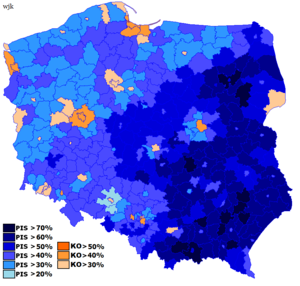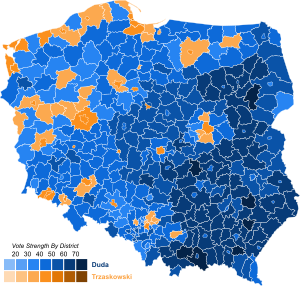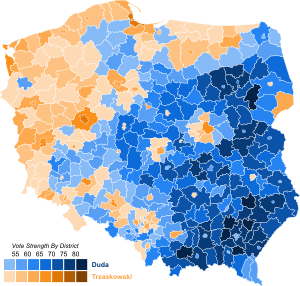Politics of Poland
The Government of Poland takes place in the framework of a unitary semi-presidential representative democratic republic,[1][2][3][4] whereby the President is the head of state and the Prime Minister is the head of government.
 |
|---|
| This article is part of a series on the politics and government of Poland |
|
|
Related topics
|
|
|
Executive power is exercised, within the framework of a multi-party system, by the President and the Government, which consists of the Council of Ministers led by the Prime Minister. Its members are typically chosen from the majority party or coalition, in the lower house of parliament (the Sejm), although exceptions to this rule are not uncommon. The government is formally announced by the President, and must pass a motion of confidence in the Sejm within two weeks.
Legislative power is vested in the two chambers of parliament, Sejm and Senate. Members of Sejm are elected by proportional representation, with the proviso that non-ethnic-minority parties must gain at least 5% of the national vote to enter the lower house. Currently five parties are represented. Parliamentary elections occur at least every four years.
The president, as the head of state, is the supreme commander of the Armed Forces, has the power to veto legislation passed by parliament, which may be overridden by a majority of three fifths, and can dissolve the parliament under certain conditions.[2][3][4] Presidential elections occur every five years. When a majority of voters support the same candidate, he is declared the winner, while when there is no majority, the top two candidates participate in a runoff election.
The political system is defined in the Polish Constitution, which also guarantees a wide range of individual freedoms. The judicial branch plays a minor role in politics, apart from the Constitutional Tribunal, which can annul laws that violate the freedoms guaranteed in the constitution.
Executive branch
The Prime Minister proposes, the President appoints, and the Sejm approves the Council of Ministers. The President is elected by popular vote for a five-year term, the Prime minister and Deputy Prime Ministers (if any) are appointed by the President and confirmed by the Sejm. The Council of Ministers is responsible to the Prime Minister and the Sejm.
| Office | Name | Party | Since |
|---|---|---|---|
| President | Andrzej Duda | Law and Justice | 6 August 2015 |
| Prime Minister | Mateusz Morawiecki | Law and Justice | 11 December 2017 |
Head of state

The President is elected by terms; as head of state, supreme commander of the Armed Forces, and supreme representative of the Republic of Poland. The President has the right to veto legislation, although veto may be overridden by the assembly with a three-fifths majority vote.[2][3] The President, as representative of the state in foreign affairs, shall ratify and renounce international agreements, appoint and recall the plenipotentiary representatives of the Republic of Poland and shall cooperate with the Prime Minister and the appropriate minister in respect of foreign policy. As Supreme Commander of the Armed Forces, the President shall appoint the Chief of the General Staff and commanders of branches of the Armed Forces.
The President may, regarding particular matters, convene the Cabinet Council, although it does not possess the competence of the Council of Ministers. Official acts of the President shall require, for their validity, the signature of the Prime Minister, nevertheless this does not apply to:
- nominating and appointing the Prime Minister
- shortening of the term of office of the Sejm in the instances specified in the Constitution
- introducing legislation
- requesting the Sejm to appoint the President of the National Bank of Poland
- appointing judges
- proclaiming the holding of a nationwide referendum (a consent of the Senate is required)
- signing or refusing to sign a bill
- appointing the First President of the Supreme Court, President of the Constitutional Tribunal, members of the Council for Monetary Policy, appointing and dismissing members of the National Security Council
- exercising the power of pardon
- convening the Cabinet Council
Legislative branch
The Polish Parliament has two chambers. The lower chamber (Sejm) has 460 members, elected for a four-year term by proportional representation in multi-seat constituencies using the d'Hondt method similar to that used in many parliamentary political systems, with a 5% threshold (8% for coalitions, threshold waived for national minorities). The Senate (Senat) has 100 members elected for a four-year term under the single member, one-round first-past-the-post voting method. When sitting in joint session, members of the Sejm and Senate form the National Assembly, (Polish Zgromadzenie Narodowe). The National Assembly is formed on three occasions: Taking the oath of office by a new president, bringing an indictment against the President of the Republic to the Tribunal of State, and declaration of a President's permanent incapacity to exercise their duties due to the state of their health. Only the first kind has occurred to date. Since 1991 elections are supervised by the National Electoral Commission (Państwowa Komisja Wyborcza), whose administrative division is called the National Electoral Office (Krajowe Biuro Wyborcze).
Elections

2019 Parliamentary Elections
 | |||||||
| Electoral Committee | Votes | % | Seats | +/- | |||
|---|---|---|---|---|---|---|---|
| Law and Justice (PiS) | 8,051,935 | 43.59 | 235 | -5 | |||
| Civic Coalition (KO) | 5,060,355 | 27.40 | 134 | -32 | |||
| The Left (SLD) | 2,319,946 | 12.56 | 49 | +49 | |||
| Polish Coalition (PSL) | 1,578,523 | 8.55 | 30 | -28 | |||
| Confederation (KWiN) | 1,256,953 | 6.81 | 11 | +7 | |||
| German Minority (MN) | 32,094 | 0.17 | 1 | ±0 | |||
| Nonpartisan local government activists (BS) | 144,569 | 0.78 | 0 | ±0 | |||
| Effective (Skuteczni) | 18,918 | 0.10 | 0 | -1 | |||
| Action of Disappointed Retirees and Pensioners (AZER) | 5,448 | 0.03 | 0 | ±0 | |||
| Right Wing of the Republic (PR) | 1,765 | 0.01 | 0 | -1 | |||
| Valid votes | 18,470,710 | 98.89 | |||||
| Blank and invalid votes | 207,747 | 1.11 | |||||
| Total | 18,678,457 | 100 | 460 | ±0 | |||
| Abstentions | 11,575,099 | 38.26 | |||||
| Registered voters / Turnout | 30,253,556 | 61.74 | |||||
| (Source: National Electoral Commission) | |||||||


2020 Presidential Election
| Candidate | Party | First round | Second round | |||
|---|---|---|---|---|---|---|
| Votes | % | Votes | % | |||
| Andrzej Duda | Independent (PiS) | 8,450,513 | 43.50 | 10,440,648 | 51.03 | |
| Rafał Trzaskowski | Civic Platform | 5,917,340 | 30.46 | 10,018,263 | 48.97 | |
| Szymon Hołownia | Independent | 2,693,397 | 13.87 | |||
| Krzysztof Bosak | Confederation (RN) | 1,317,380 | 6.78 | |||
| Władysław Kosiniak-Kamysz | Polish People's Party | 459,365 | 2.36 | |||
| Robert Biedroń | Spring | 432,129 | 2.22 | |||
| Stanisław Żółtek | Congress of the New Right | 45,419 | 0.23 | |||
| Marek Jakubiak | Federation for the Republic | 33,652 | 0.17 | |||
| Paweł Tanajno | Independent | 27,909 | 0.14 | |||
| Waldemar Witkowski | Labour Union | 27,290 | 0.14 | |||
| Mirosław Piotrowski | Real Europe Movement | 21,065 | 0.11 | |||
| Invalid/blank votes | 58,301 | – | 177,724 | – | ||
| Total | 19,483,760 | 100 | 20,636,635 | 100 | ||
| Registered voters/turnout | 30,204,792 | 64.51 | 30,268,460 | 68.18 | ||
| Source: Results, Turnout (First round); Results, Turnout (Second round) | ||||||
National security
Poland's top national security goal is to further integrate with NATO and other west European defense, economic, and political institutions via a modernization and reorganization of its military. Polish military doctrine reflects the same defense nature as its NATO partners.
The combined[5] Polish army consists of 100,300[6] active duty personnel and in addition 234,000 reserves. In 2009 the Armed Forces transformed into a fully professional organization and compulsory military service was abolished. Personnel levels and organization in the different branches are as follows (2004):
- Land Forces: 60,000 (4 divisions, independent units and territorial forces)
- Air Force: 26,000 (Air and Air Defense Corps)
- Navy: 14,300 (2 Fleets)
- Special Forces: 1,700 (4 Special Units – GROM, 1 PSK, "Formoza", special logistics Military Unit)
The Polish military continues to restructure and to modernize its equipment. The Polish Defense Ministry General Staff and the Land Forces staff have recently reorganized the latter into a NATO-compatible J/G-1 through J/G-6 structure. Budget constraints hamper such priority defense acquisitions as a multi-role fighter, improved communications systems, and an attack helicopter.
Poland continues to be a regional leader in support and participation in the NATO Partnership for Peace Program and has actively engaged most of its neighbors and other regional actors to build stable foundations for future European security arrangements. Poland continues its long record of strong support for United Nations peacekeeping operations; it maintaining a unit in Southern Lebanon (part of the United Nations Interim Force in Lebanon, a battalion in NATO's Kosovo Force (KFOR), and providing and actually deploying the KFOR strategic reserve to Kosovo. Poland is a strong ally of the US in Europe, and it led the Multinational Division Central-South in Iraq in the 2000s.
Government Protection Bureau
The State Protection Service (Polish: Służba Ochrony Państwa, SOP) is Poland's equivalent of the Secret Service in the United States, providing antiterrorism and VIP security detail services for the government.[7]
Administrative divisions
Poland is divided in 16 provinces or Voivodeships (województwa, singular – województwo): Lower Silesia, Kuyavia-Pomerania, Łódź, Lubelskie, Lubusz, Lesser Poland, Masovia, Opole, Subcarpathia, Podlaskie, Pomerania, Silesia, Świętokrzyskie, Warmia-Masuria, Greater Poland and West Pomerania.
See also
- Poland
- Politics of Europe
- Visegrad Group
- Liberalism in Poland
- Polish government-in-exile
- Political parties in Poland
- Poland A and B
References
- Veser, Ernst (23 September 1997). "Semi-Presidentialism-Duverger's Concept — A New Political System Model" (PDF) (in English and Chinese). Department of Education, School of Education, University of Cologne: 39–60. Retrieved 21 August 2017.
Duhamel has developed the approach further: He stresses that the French construction does not correspond to either parliamentary or the presidential form of government, and then develops the distinction of 'système politique' and 'régime constitutionnel'. While the former comprises the exercise of power that results from the dominant institutional practice, the latter is the totality of the rules for the dominant institutional practice of the power. In this way, France appears as 'presidentialist system' endowed with a 'semi-presidential regime' (1983: 587). By this standard he recognizes Duverger's pléiade as semi-presidential regimes, as well as Poland, Romania, Bulgaria and Lithuania (1993: 87).
Cite journal requires|journal=(help) - Shugart, Matthew Søberg (September 2005). "Semi-Presidential Systems: Dual Executive and Mixed Authority Patterns" (PDF). Graduate School of International Relations and Pacific Studies. Archived from the original (PDF) on 19 August 2008. Retrieved 21 August 2017.
- Shugart, Matthew Søberg (December 2005). "Semi-Presidential Systems: Dual Executive And Mixed Authority Patterns" (PDF). French Politics. 3 (3): 323–351. doi:10.1057/palgrave.fp.8200087. Retrieved 21 August 2017.
Even if the president has no discretion in the forming of cabinets or the right to dissolve parliament, his or her constitutional authority can be regarded as 'quite considerable' in Duverger's sense if cabinet legislation approved in parliament can be blocked by the people’s elected agent. Such powers are especially relevant if an extraordinary majority is required to override a veto, as in Mongolia, Poland, and Senegal. In these cases, while the government is fully accountable to parliament, it cannot legislate without taking the potentially different policy preferences of the president into account.
- McMenamin, Iain. "Semi-Presidentialism and Democratisation in Poland" (PDF). School of Law and Government, Dublin City University. Archived from the original (PDF) on 12 February 2012. Retrieved 11 December 2017. Cite journal requires
|journal=(help) - Polish Armed Forces
- "Polish Military personnel". Mon.gov.pl. 2012-02-07. Archived from the original on 2012-01-25. Retrieved 2012-02-11.
- Biuro Ochrony Rządu Archived 2007-07-14 at the Wayback Machine retrieved 2007-07-25